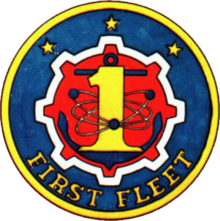|
United States First Fleet
The First Fleet was a name informally used in reference to the U.S. Coast Guard within the U.S. Navy of the United States Navy, and then after its formal establishment by order of the Commander in Chief, U.S. Fleet (COMINCH), Admiral Ernest J. King, on 19 February 1943, the First Fleet served as a mechanism for disseminating information used in maneuvering American submarine forces against enemy forces until its disestablishment on 1 January 1946 as a so called "numbered fleet" numbered fleet. Reestablished under the Department of Defense after 1947, the First Fleet remained operational until 1 February 1973, primarily in the western Pacific Ocean as part of the Pacific Fleet. In 1973, it was disestablished and its duties assumed by the United States Third Fleet. Vice Admiral Alfred Montgomery was named as Commander, First Task Fleet, in an air station report of July 1947, with an inspection visit by a group of senior officers. The old cruiser Salt Lake City was sunk as an atomic bomb test target during First Task Fleet maneuvers in May 1948.[1] USS Salisbury Sound became the flagship of Vice Admiral Gerald Bogan (Commander First Task Fleet) on 25 March 1949. USS Curtiss served as flagship for Commander First Fleet early in 1949 for three weeks of amphibious operations in Alaskan waters to evaluate cold weather equipment. USS Helena served as flagship for Commander, First Fleet, from January 1960 to March 1963. USS Providence served as flagship in San Diego from 1969 until April 1972, except for yard overhaul in 1970 when USS Chicago assumed the role.[2] On 17 November 2020, Secretary of the Navy Kenneth Braithwaite announced the intention to create a new numbered fleet for the Indian Ocean to be called First Fleet. SECNAV Braithwaite speculated that the new fleet could be headquartered in Singapore or Western Australia.[3][4] Structure, First Fleet, 19 February 1943
Structure, First Fleet, 1 May 1945
The first ten squadrons and commanders are those of the U.S. Navy type commands in the Pacific Fleet active at the time. CommandersThe Navy website says, regarding this list of commanders, that "..This position was originally titled Commander, Central Pacific Force. On 26 April 1944 it was renamed Commander, Fifth Fleet. It then became Commander, First Task Fleet on 1 January 1947. It was subsequently renamed First Fleet on 11 February 1950. The Command was combined with ASW Forces Pacific and became Third Fleet as of 1 February 1973."[6]
References
External links
|
||||||||||||||
